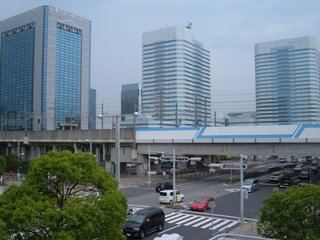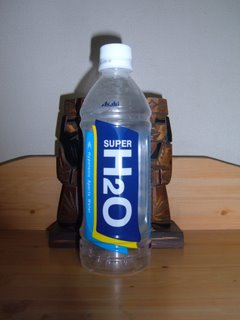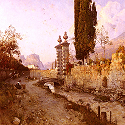On wanting to grab onto something and hold on tightly
"So", I know you're all wondering, "what is this town that you go through every morning to get to school like?" Actually, this is completely untrue--if you are wondering that, I sure as heck don't know it--but I'm going to talk about it some anyway. Besides, there's no way I'm going to talk about that chapter test today.
Makuhari New City was first conceived of in the early 1980s. Chiba, the Newark to Tokyo's New York (but with less crime and toxic waste), was attempting to reinvent itself as both a safe suburb and a thriving business center in its own right. One of the centerpieces for this movement focused on a patch of land that was, at the time, being reclaimed from Tokyo Bay and made fit for settlement. The planned city would become a high-tech haven for businesses, a residential complex convenient to Tokyo, Narita International Airport, and Chiba City, and a seaside center for conventions and entertainment. With the completion of the gigantic Makuhari Messe convention center in October 1989, Makuhari New City was declared 'open'.
Pretty much every decent space within fifty miles of the Imperial Palace has been developed for quite some time, but Makuhari still stands out above the density surrounding it. There's about two dozen buildings taller than thirty stories within a few square miles, including the headquarters of Seiko, Canon, BMW Japan, and various hotels.
Even more interesting, though, is what doesn't stand out. Unlike virtually all of downtown Tokyo, Makuhari was designed with an elaborate system of parks and greenbelts. Some snake across the entire city, with benches, fountains, and all sorts of greenery. Another larger park, next to the station, is wider and has a manmade beach at its end. Sidewalks, bridges, and other such infrastructure is very common, making Makuhari ideal for its 20,000 pedestrian residents and 100,000 commuting students and 'salarymen'.

Makuhari is divided up into several loose districts: the residential zone, corporate zone, education zone, and entertainment zone. The latter, which gets most of the beach space, is home to Chiba Marine Stadium, Makuhari Messe, and some pretty large shopping centers and movie theaters.
Anyway, I haven't had time to go see about two-thirds of this--but it's certainly nice to know it's there. If you ever go to Tokyo, it may not necessarily be worth your while to travel the forever out to Kaihin-Makuhari Station, but there are certainly worse ideas.
Vending Machine Special: Super H2O

It's a bird! It's a plane! It's... another generic energy drink!
You may have noticed by now that there aren't too many different drink manufacturers in these pictures. Pretty much 95% of the drink machines I've seen in Japan are run by one of three companies: Asahi, Suntory, and Pokka. Interestingly, Asahi and Suntory are primarily known for their beer and other alcoholic drinks. (Yes, that's the Suntory of "For relaxing times... make it Suntory time" fame.)
[A few more pictures later this week.]







4 Comments:
Mr. Russ, I believe I have found a terrific Facebook group that you need to join called "If you can't get into college, go to State".
http://arizona.facebook.com/group.php?gid=2204523839\
Hugs and Kisses
Actually, the smartest person I ever knew is attending ASU now. I'll get around to it, though.
oh yeah... oh yeah??? well, we got H2GO and... and... a pineapple with a mouth on it, and... PUMP and... lots of energy waters like that. it's almost scary.
Man, if I put up a picture of every energy drink I've seen here it would crash Blogger.
Post a Comment
<< Home